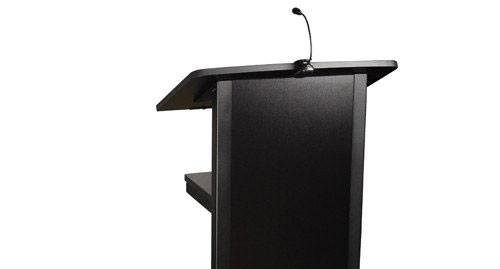As a Presentation Skills speaker and trainer, I have seen and read pretty much every article, video and book on the topic that I can get my hands on. Public speaking books, Harvard Business Review articles on how to pitch, TED TALKS, books, presentation skills blogs, books on Pitching, Presenting, PowerPoint – I have probably seen them all.
Interestingly, almost all of them suggest that speakers do not use the lectern. ‘Leave the lectern alone’ they say, ‘the lectern shields you from the audience’, ‘the lectern creates a barrier to good, open communication’, ‘always use the stage’ they urge, ‘walk to the audience so you can engage better with them’…and so on.
Put simply the common wisdom seems to be Lectern BAD, Stage GOOD. Respectfully, I disagree.
I am not embarrassed to admit but I love the lectern and believe that it is one of many useful tools available to a speaker or MC. I certainly don’t use it all the time and when doing a full keynote style presentation, I will spend the bulk of my time walking around, away from the lectern, using the stage.
However, when MCing a conference, for which I always have mountains of notes, the lectern is invaluable for me and my style of speaking / facilitation and it serves as a central location to focus the attention of the audience between speakers.
On the conference circuit, I regularly see many brilliant speakers camp themselves at the lectern and emote beautifully, telling stories, using only the upper part of their body to gesture, keeping an eye on their notes, leaning on the lectern, or simply basing themselves there, because, well, it makes them more comfortable.
While I also see many great speakers not using the lectern and you have all probably seen countless wonderful TED TALKS featuring brilliant speakers standing fully exposed on the round, red piece of TED carpet, that in no way diminishes the power of the lectern for others.
One of the greatest communicators this century Barack Obama uses the lectern and always owns the room. Closer to home, one of Australia’s best and best-loved presenters Ita Buttrose speaks eloquently from behind a lectern. Last month at a NAB event I saw Jeff Kennett hold 1000 people spellbound, without ever leaving the lectern.
I strongly believe that a presenter should do whatever makes them more comfortable, provided that engaging the audience remains their prime focus. If you need to glance at your notes from time to time, go for it. If anything a quick look at your notes subtly tells the audience that you have prepared for this presentation. If you as the presenter are in your comfort zone (and having your notes at the ready for some, spells comfort), then your audience will benefit. If holding the lectern makes you feel less nervous or less vulnerable, then go for it. However, nervous speakers should try not to see the lectern as a shield to hide behind.
All of this definitely does not mean that using the stage is a no-no. On the contrary, if you’ve never ventured out from the lectern, it is certainly worth a try. Good stage-craft can make your presentation extremely powerful (and that’s a post for another time).
Ultimately, the lectern is a great presentation tool, if used properly and strategically. To the anti-lectern nay-sayers out there in presentation land, to the anti-lectists, I say leave the lovely and often lonely little lectern alone.
Andrew Klein is a Presentation Skills speaker/trainer and a Professional Conference MC. He can be found either wandering the stage when presenting or possibly lounging at the lectern. He also makes up words like “anti-lectist” from time to time.




